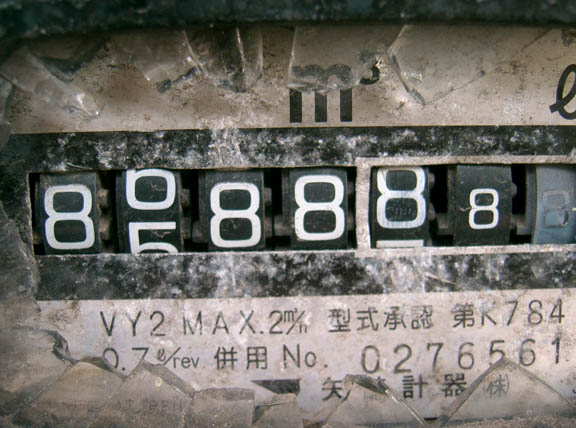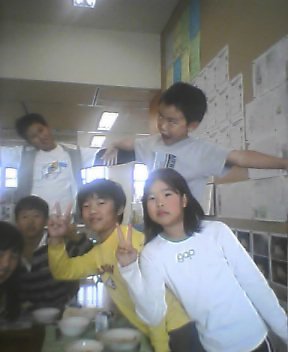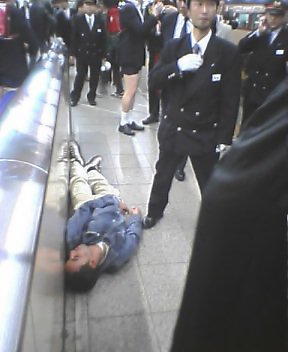
This meter is my good luck charm, located some place that no one will ever discover, frozen for the rest of time showing almost all eights.
Crazy 8’s
Reaching for the Stars

This is an actual toy set that is currently for sale at Toys R Us in Japan. Can you picture some little kid asking for this? Mommy, when I grow up I want to work at McDonalds!
All jokes aside, working at Mickey D’s doesn’t have the same stigma attached to it over here as id does back home. The workers do their jobs with pride and efficiency, and the clerks that I have talked genuinely seem to like their jobs.
Another indicator that things are way different over here: I haven’t even heard any stories about disgruntled employees spitting in (or mixing various bodily fluids in) the food or beverages. So maybe Japanese McDonalds is better than the McDonalds in the States after all.
A “Slapping the Forehead” Moment
Today, when I was teaching “Let It Be” to my high schoolers, I asked a teacher to translate the phrase “let it be” into Japanese. He then said the phrase in katakana English and waited for me to proceed with the lesson. I looked at him in bewilderment and said “No, in Japanese please”, to which he replied “hakuna matata!”. I lost the struggle to maintain composure, unsuccessfully trying to contain frustruated laughter as I asked him again. He answered “se la vie”. Smack! Not that I was being melodramatic, it was a parasympathetic response that caused my hand to slap my forehead with such force. And that’s pretty much how that lesson went for that particular class.
Jesus Christ Pose (kid version)

I was eating kyushoku with the kids at my elementary school, when they asked me why I spike my hair. I told them “God told me to”, and for some reason, the kid on the right stood up on a chair and acted out dying on the cross. “I’m Jesus Christ!” he said as the other kids laughed. It was so offensive, that I couldn’t contain my laughter. As I was laughing, the words “Blashpemer! You’re going straight to hell!” jumped into my head. Ah, I love teaching at elementary school.
The incident reminds me of the story about the Japanese department store in Tokyo that displayed a smiling crucified Santa during Chrismas. Its disappointing when you can’t confirm a good story like this.
Today’s Special Announcement
It turns out that we are the first school in Osaka to have spotted the South-American red-backed black widow! Yay!
Why JR employees don’t like Halloween

After everyone disembarked from the Halloween Weekend Loop Line Party, the JR crowd control staff gathered around this guy who was out cold on the platform and did… well they really didn’t do much of anything. They tried shaking him awake and prodded him like a piece of cold mutton, but then gave up and took a few minutes to ponder as a group the following questions:
Why the hell did I get chosen to work on this stinking weekend? Why the hell did all of those stupid foreigners choose to get together and act so stupidly on the train? Did they really think that dressing up in costumes, scaring the natives, drinking in public, switching cars in a mad dash whenever arriving at a new station and just acting like fools in general made for a good time? Should I be more concerned about that warm liquid that soaked through my pants when I was pressed up against that big flabby gaijin man dressed in the nursery school boy outfit (he’s in the background of the picture, BTW)?
Apparently, the answer to the second to last question is yes because they come back year after year. It was amusing to see, but it wasn’t really any different from a typical weekend in Isla Vista back at UCSB, except for being in Japan on a train. If you want to see Japanese have a mix of apathetic resignation, utter fear, morbid curiosity, or acquired distaste of groups of gaijin in general, then all you need to do is to attend this annual anti-matsuri and you will see. Or you will drink too much and hear from your friends (and other random people that you bump into) about how much of an ass you made of yourself (again, it’s the same as any given night in IV).
We didn’t stay long enough to see what became of the non-costumed dude on the ground (maybe he was just an unrelated bystander who happened to pass out on the platform), but I bet he was pretty confused when he woke up to the sight of ten JR employees looking down at him. And if he was lucid, perhaps he noticed that the looks on their faces were more of contempt and irritation rather than genuine concern.
Mean Train Grannies
Today, as I moved aside to offer the old lady behind me the last seat on the train I was shocked to recieve a two-handed full-body thrust push that spun me around. I couldn’t help smiling at the sheer rudeness as she defiantly glared into my eyes!
I must point out that there are many more nice old people there are on the train who are greatful whenever you give up your seat, but it’s the cantankerous old hags and old sloppy drunk dudes that are the most memorable. Too bad nice people don’t tend to stick in one’s memory the way nasty ones do. Still though, I can’t help but laugh at the mean grannies on the train…
Motivational Competitions
It causes siblings to try to best their brothers and sisters, it causes classes and schools to forget social heirarchy for a bit and come together to defeat their rival teams, and it was the catalyst that spurred on many brilliant minds and philanthropists to make privatized space travel a reality.
X-Prize founder Peter Diamandis kicked off the PopTech conference here with a lofty goal on Thursday: “Our mission is to bring about radical breakthroughs,” he said in his opening-day address.
(link)
But I wonder if the public’s imagination can be captivated by the final frontier on Earth as it was by Burt Rutan’s Spaceship 1’s triumph. Space travel and colonization are fascinating, but there is so much that is yet to be discovered on Earth that we could be focusing on in the mean time. Alternative energy sources, undiscovered life forms, and how the many different systems of the Earth work together are just some of the stuff we could better understand if there was more interest, funding, and research put into the marine sciences.
The article mentions the discovery of a deep-sea microbe that eats methane and farts out elemental hydrogen. Now, if only we could capture cow burps, have the bacteria convert them, and use the hydrogen to power our cars, we could reduce bovine greenhouse gas emissions and tap into a previously unimagined source of energy! Dude, that prize is so mine!
Okinawa Revisited
The lovable blenny defends his mighty kingdom against any diver foolish enough to invade his territory, until you get too close at which time he zips back into the safety of a small hole
As I review these pictures from my dives in Okinawa they awaken a hunger for spam, a thirst for good awamori, and a strong urge go to the beach and jump into the sapphire waters that lap the shores of the Ryukyu islands.
And the fish! They were so colorful and delicious that I found myself doing something at Churami Aquarium that I have always poked fun at Japanese tourists for doing whenever they visit any aquarium.
After picking out fresh fish at the market and having the restaurants, situated one floor above, turn it all into a delicious meal, I couldn’t help but stare through the 6 inch thick plexiglass and think of a feast. I remember thinking, “Damn, that mahi mahi would go excellent with a big frosty glass of Orion beer!”.
The warm twang of the sanshin and the crashing surf are beckoning to me, inviting me back with promises of kicking back on the beach with a drink in hand and a full belly after a long day spent in the water. I hope I can make it back to those beautiful islands some day, the sooner the better.
Capoeira West Batizado 2005 Pictures

Yo, pictures are up from the Capoeira West 2005 Batizado:
The batizado brought together groups from all over to Japan, allowing the participants to play against players using a variety of styles and techniques. It was fascinating to see the game being played by such high level players, to observe how the balances between trickery, speed, flexibility, acrobatics, and strength affect the mood and pacing of the game.
The coolest thing about this martial art is that if you look at the faces of the participants, almost everyone is wearing a smile and is having a good time. Though sometimes it is appropriate to strike another player and to inflict injury, mostly the participants do not play to hurt each other, and rather just demonstrate moves rather than carry a potentially dangerous kick or sweep to completion.
I?ve been told that you have to be careful when you play with students from other schools, but I?ve only heard and read about ruthlessness in the roda second-hand. From what I’ve seen in Japan, capoeira does not tend to attract the same meatheads, the guys who are out there to prove their manliness by exerting dominance on every one, that other martial arts do.
I often hear people say that capoeira is not effective as a martial art. Then why haven’t we seen people use it in Pride, UFC, or K1? Well, in these venues, other martial arts have an edge. For pit fight situations like these muay thai, jiu-jitsu, shoot fighting, etc… give a fighter the edge. I would also argue that, like Aikido, it takes a lot of time and practice before one can use it to fight proficiently in contrast to the relatively little training it takes someone learning jiu-jitsu before that training can be effectively applied in a real fight situation. But mostly, choosing to engage in such a fight goes against the philosophy of capoeira, which preaches cunning and trickery over brute strength.
Luring an opponent into attacking and then springing a trap when they least expect it is how the capoerista would choose to engage an enemy. For example, he might feign a retreat or a fall to the ground, and then instantly spring back and ambush the attacker with a powerful kick. And if he is at a disadvantage or starts losing the fight, then running away is a completely acceptable option. This is no Cobra Kai approach to life.
Mestre Bimba was once asked “What would you do if someone pointed a gun to your chest?” to which he replied “Then I would die, my son.”. There is no conventional sense of “honor” in this martial art, which was built from the practical knowledge of those who needed to protect themselves and fight outnumbered and outgunned, against all odds. Survival and learning to thrive amid the hardships of life are the values inherent in capoeira.
In Brazil, capoeiristas are known to fight holding razorblades in their hands and between their toes. The lateral shift of the jinga, the use of cartwheels and acrobatics, and the dazzling movements on the ground look a lot more dangerous if you can picture how these graceful movements could be used to slice and dice an unwary opponent. It?s interesting to note that members of the older generation are viewed both as lawless thugs and as protectors against the government and police. Many of them kept the nightsticks of police that they had defeated in street fights as trophies, and one famous capoeirista actually went into police headquarters and returned his sizable collection to them as a taunt (In case you were interested, these accounts were taken from Capoeira: A Brazillian Art Form by Bira Almeida and The Little Capoeira Book by Nestor Capoeira). Now that?s bad ass.

